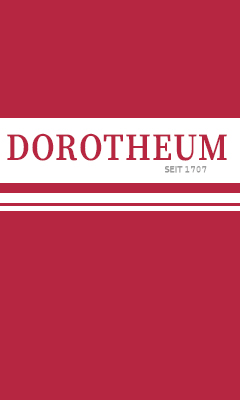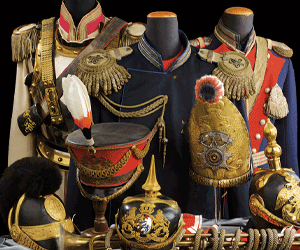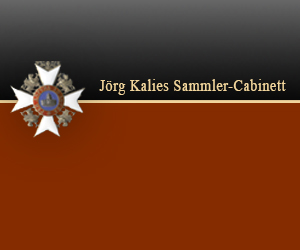SA (Gebirgs-)Jäger/Schützen Collar Tabs
SKU: 51.GOR.03.02.02.03.010
Estimated market value:

Estimated market value:
Attributes
History
The SA (Sturmabteilung, storm detachment) was established in 1921 as a paramilitary protection squad of the NSDAP. The members of the SA were tasked with protecting party leaders at political rallies and meetings from the paramilitary forces of the opposing political factions. The SA was first utilised on November 4, 1921 at a meeting held in Munich’s "Hofbräuhaus" beer hall. The organisation was banned after the failed putsch in 1923 and was reactivated in February 1925.
Collar tabs were introduced on November 11, 1926. The left collar tab was used to determine the wearer’s rank, while the right one determined the wearer’s unit. The rank pips on the left rank collar tab were made of white metal.
Collar tabs are in the shape of a parallelogram and measure approximately 40x58mm (without piping).
The earliest rank system was as follows:
Standartenführer wore four pips forming a square.
Sturmführer wore three diagonal pips.
Truppführer wore two pips in a horizontal line.
Gruppenführer wore one pip.
Enlisted men wore no pips.
Members of all regions wore silver-coloured buttons and pips, except for members of regions Baden, Thüringen, Österreich, Mecklenburg, and Hannover, who wore gold-coloured buttons and pips.
Arabic numbers were used to indicate membership in a Sturm, while Roman numerals were used for a Standarte or Brigade. The piping was in the same colour as the numerals.
The collar tab base colours were based on the wearer’s region. The following list was introduced on November 12, 1926 and contains the collar tab colour followed by the numeral and piping colour, followed by the region(s) that used them:
White/red: Schleswig-Holstein, Hamburg, Lübeck
White/yellow: Hannover
White/green: Halle, Merseburg, Magdeburg, Anhalt
White/light blue: Franken, Nordbayern
Dark red/white: Böhmen
Yellow/white: Schlesien
Yellow/red: Baden
Yellow/black: Mecklenburg
Green/white: Sachsen
Green/black: Thüringen
Light blue/white: München, Oberbayern, Schwaben, Niederbayern
Light blue/red: Hessen
Dark blue/red: Friesland, Oldenburg, Bremen
Black/white: Berlin, Brandenburg, Ostmark, Pommern
Black/red: Württemberg
Black/yellow: Österreich
Black/green: Ruhr
The following list contains additions and changes made on August 4, 1929 for the collar tab base colours. Unfortunately, no information is available on number and piping colours.
Red: High Leaders
White: Ostpreußen, Danzig, Brandenburg, Ostmark
Yellow: Magdeburg, Anhalt, Halle-Merseburg, Franken
Green: Lüneburg, Nordmark
Blue: Pommern, Mecklenburg, Rheinland, Nassau, Bayern
Brown: Hannover, Friesland, Österreich
Black: Pfalz
A new rank structure was introduced on April 22, 1931:
Stabschef (chief of staff): red collar tabs with golden piping and golden oak leaves on both tabs.
Gruppenführer: red collar tabs with silver piping and silver oak leaves on both tabs.
Untergruppenführer/Standartenführer: collar tabs in regional colour with golden or silver piping and golden or silver oak leaves on both tabs.
Sturmbannführer: collar tabs in regional colour, with two-colour regional piping. Four pips on rank collar tab.
Doctors wore violet collar tabs with golden piping, with a golden medical staff and golden oak leaf.
Geldverwalter (finance administrators) wore collar tabs corresponding with their rank, but with a laurel leaf instead of an oak leaf.
The rank structure was modified on November 28, 1931:
Stabschef (chief of staff): now wore a golden star surrounded by an oak leaf wreath on the collar tabs.
High Leader ranks, including Obergruppenführer, Gruppenführer, Oberführer, and Standartenführer.
Medium Leader ranks, including Sturmbannführer and Sturmführer.
Lower Leader ranks, including Truppführer and Scharführer.
SA-Männer (enlisted ranks).
Collar tab colours in 1931 were as follows, with the tab colour followed by the region(s) that used them, followed in parentheses by the number colour and the button and cypher colour (combining collar tab colour and number colour provides the region’s two-colour piping colours):
White: Brandenburg and Ostmark (red, silver); Danzig and Ostpreußen (black, silver); Hamburg (green, gold)
Yellow: Baden (red, gold); Franken (black, gold); Halle-Merseburg and Magdeburg-Anhalt (green, gold); Schlesien (white, silver)
Green: Nordmark (red, gold); Sachsen (white, silver), Thüringen (black, gold)
Blue: Hessen-Darmstadt, München-Oberbayern, Oberpfalz-Niederbayern, Schwaben (white, silver); Hessen-Nassau-Nord (yellow, silver); Hessen-Nassau-Süd (red, silver); Mecklenburg and Pommern (yellow, gold); Rheinland-Nord and Rheinland-Süd (black, silver)
Brown: Hannover-Süd (yellow, gold); Österreich (white, silver); Weser-Ems (green, silver)
Black: Düsseldorf, Essen, Westfalen-Nord, Westfalen-Süd (green, silver); Berlin (white, silver); Hannover-Ost (yellow, gold); Pfalz-Saar (blue, gold); Württemberg (red, silver)
The collar tabs were finally standardised in 1933, after which they basically remained the same with only minor changes until 1945.
The following list provides information on the left rank collar tab. Beginning with the rank of Standartenführer, these higher leader ranks wore the same rank collar tab on both sides. Lower ranks wore a rank collar tab on the left and a unit collar tab on the right.
Stabschef (chief of staff): six-pointed star inside an oak leaf wreath (changed to three oak leaves inside a laurel wreath in late 1934), gold piping
Obergruppenführer: three silver oak leaves and one pip, silver piping
Gruppenführer: three silver oak leaves, silver piping
Brigadeführer: two oak leaves and one pip, gold or silver piping
Oberführer: two oak leaves, gold or silver piping
Standartenführer: one oak leaf, gold or silver piping
Obersturmbannführer: four pips and one bar of braid, gold or silver piping
Sturmbannführer: four pips, gold or silver piping
Hauptsturmführer (renamed Sturmhauptführer in early 1934): three pips and two bars of braid, two-colour piping
Obersturmführer: three pips and one bar of braid, two-colour piping
Sturmführer: three pips, two-colour piping
Haupttruppführer (established 1941): two pips and two bars of braid
Obertruppführer: two pips and one bar of braid
Truppführer: two pips
Oberscharführer: one pip and one bar of braid
Scharführer: one pip
Rottenführer: two bars of braid
Sturmmann (renamed to Obersturmmann in 1941): one bar of braid
SA-Mann (renamed to Sturmmann in 1941): blank collar tab
The bars of braid worn at the bottom of the rank collar tab by several ranks have a dividing centre line.
(Gebirgs-)Jägerstandarten and Schützenstandarten used light and dark green (respectively) braids and numbers in conjunction with the letters “(G)J” or “S”, respectively. The dividing centre line of the braid is in the colour of the collar tab. Beginning on May 20, 1941, their number colour was changed to white. Later that year, their special braid colours were discontinued.
In early 1934, two-colour piping was briefly introduced for all ranks from Sturmhauptführer down to SA-Mann. In late 1934, two-colour piping around the collar tabs was again only used by ranks Sturmhauptführer, Obersturmführer, and Sturmführer.
In early 1933, a new region system was established. The following is a list of collar tab colours, followed by the region(s) that used them, with the following information in parentheses: number colours, two-colour piping colours, button colour, and braid colour (with the first colour being the braid itself, and the second the braid’s dividing centre line).
Pink (changed to red-pink in late 1934): Ostmark (black, black/white, gold, white/black); Kurpfalz (established early 1934, changed to steel-green in late 1934) (white, black/white, silver, white/black); Südmark (established in 1939) (white, silver, white/red)
Dark wine-red: Ostland (white, black/white, gold, white/black); Westfalen (white, black/white, silver, white/black)
Red-brown: Österreich (beginning early 1934) (renamed Alpenland in 1939) (white, red/white, silver, white/red); Donau (established in 1939) (yellow, gold, white/red)
Dark brown: Westmark (white, black/white, silver, white/black); Niedersachsen (white, black/white, gold, white/black)
Yellow: Schlesien (white, black/white, silver, white/black); Franken (black, white/blue, gold, black/blue)
Orange-yellow: Mitte (black, black/white, gold, white/black); Südwest (black, black/orange-yellow, silver, black/orange-yellow)
Apple-green: Pommern (white, black/white, gold, white/black); Thüringen (white, white/red, silver, white/red)
Emerald-green: Sachsen (white, white/emerald-green, silver, white/emerald-green); Nordmark (white, black/white, gold, white/black)
Steel-green: Österreich (until early 1934, changed to red-brown) (white, red/white, silver, white/red); Nordsee (white, black/white, gold, white/black); Kurpfalz (beginning late 1934) (white, black/white, silver, white/black)
Light blue: Hochland (white, white/light blue, silver, white/light blue); Bayerische Ostmark (white, white/light blue, gold, white/light blue)
Navy blue: Hansa (white, light blue/yellow, gold, white/blue); Hessen (white, light blue/red, silver, white/blue)
Cornflower-blue: Warthe (established in 1939) (white, silver, silver/brown); Oberrhein (established 1941) (white, gold)
Blue-grey: Sudetenland (established in 1939) (white, gold, yellow/red); Weichsel (established in 1939) (white, silver, silver/brown)
Light grey: Generalgouvernment (established September 1, 1942) (white, silver)
Black: Niederrhein (white, black/white, gold, white/black); Berlin-Brandenburg (white, black/white, silver, white/black)
The SA Stabschef (chief of staff) wore red collar tabs with golden piping and golden buttons.
Staff members of the SA headquarters wore crimson collar tabs with crimson/golden piping for higher ranks and crimson/light orange piping for Obertruppführer and below (changed to Sturmhauptführer and below in early 1934), with golden buttons, except for Gruppenführer and Obergruppenführer who wore silver buttons (changed to silver buttons for all ranks in early 1934), and yellow (changed to white in early 1934) braids with a crimson dividing centre line. Beginning in late 1934, all members on the Staff of the SA headquarters wore crimson/white piping, silver buttons, and white braids with a crimson dividing centre line. Beginning in late 1934, these colours were also worn by members of the Wachstandarte.
Staff members on a Gruppen or Obergruppen Staff wore light red (changed to red in early 1934) collar tabs with red/silver piping for Obertruppenführer and above (changed to Sturmhauptführer in early 1934) and red/white piping for lower ranks (changed in late 1934 to white/light red for all ranks), silver buttons, and a white braid with a red dividing centre line.
Administrative leaders wore light blue velvet collar tabs with silver piping for Sturmbannführer and above and blue piping for lower ranks, with silver buttons, and a white braid with a blue dividing centre line.
Medical leaders wore violet velvet collar tabs with gold piping for Sturmbannführer and above and violet piping for lower ranks, with gold buttons, and a yellow braid with a violet dividing centre line.
The special colours for administrative and medical leaders were discontinued in early 1934, after which they wore the regular regional colour tabs.
In 1939, the two-colour regional piping was discontinued and those who wore it switched to either gold or silver piping, depending on their button colour.
On May 20, 1941, the colour of all rank badges and buttons for all ranks was changed to silver, with the exception of the Stabschef (chief of staff) and members of the Marine-SA. Enlisted ranks now wore collar tab piping in white if their former button colour had been silver, or yellow if their former button colour had been gold. Similarly, Officer ranks now wore collar tab piping in either silver or gold, depending on their former button colour. Collar tab piping for enlisted ranks was discontinued in early 1942.
Additional changes in 1941 included the following:
Several regions were renamed or replaced: Ostland to Tannenberg; Ostmark to Oder; Westmark to Mittelrhein; Mitte to Elbe; Südwest to Neckar; Bayerische Ostmark to Bayernwald.
All collar tab number colours were changed to white.
All collar tab braid colours were changed to white with a brown dividing centre stripe, and yellow with a navy blue stripe for Marine-SA members.
Ranks of Standartenführer and upwards began wearing small metal cyphers in the corner of their collar tabs to identify their unit.
As of July 1, 1943, all collar tabs for ranks Oberführer up to and including Obergruppenführer were red with silver piping, and all collar tabs for staff members of the SA headquarters were crimson with silver piping.
As of August 27, 1943, SA personnel serving outside of Germany would no longer use region colour collar tabs. Instead, lower ranks (up to and including Haupttruppführer) wore brown tabs with white piping, ranks Sturmführer up to and including Oberführer wore brown tabs with silver piping, and ranks Brigadeführer up to and including Obergruppenführer wore red tabs with silver piping.
In 1944, new collar tabs were introduced for higher leader ranks. They were produced, but probably not worn, and if so not in great numbers. All were either in red or crimson, with three silver oak leaves and silver piping. The oak leaves featured a “Wolfsangel” (wolf hook) at the bottom. Obergruppenführer wore an additional two pips, Gruppenführer one pip, and Brigadeführer wore no pips.
For enlisted ranks, unit numbers and designations were initially chain-stitched. This was replaced by embroidered numbers and designations in 1939.
Lower leader ranks usually used metal numbers and cyphers.
Cyphers for the higher leader ranks of Standartenführer and above could be hand-embroidered or made of metal.
In unit designations, the first number is smaller than second, and those numbers are separated by a slash, in the following format:
Sturm or Sturmbann/Standarte
A single number is also possible, for example in the case of staff members of the leader of a Standarte.
Members of a Motor unit used a letter “M” followed by their unit numbers, while those part of the reserve, prior to 1934, used a letter “R”.
Members of the SA Cavalry (Reiter-SA) used two crossed metal lances in front of their unit numerals between 1934 and 1941.
SA Engineers (SA-Pioniere) used a metal cypher in the form of a crossed spade and pick in front of their unit numbers between 1933 and 1941. The cypher was in gold or silver, depending on the wearer’s button colour.
For a while, members of the Flying SA (Flieger-SA) wore a metal cypher in the form of a winged propeller on their right collar tab. With the inclusion of all SA flying units into the DLV, this insignia was discontinued.
Members of the Naval SA (Marine-SA) wore a metal cypher in the form of a golden fouled anchor on their unit collar tab. (Silver anchors existed for a very brief period of time.) Marine-SA collar tabs are navy blue. The anchor cypher was discontinued in 1938 or 1939.
Prior to 1933, band members wore a numbered unit collar tab on the right side and a rank collar tab on the left that included a metal cypher in the form of a lyre (with additional rank pips where applicable). In 1933, the position of the lyre cypher was changed and it was now placed in front of the unit number on the right collar tab.
Signal SA (Nachrichten-SA) members began wearing a cypher in the form of a downward pointing bolt of lightning in front of their unit numbers in 1933. The cypher could either be gold or silver in colour, depending on the wearer’s button colour. The cypher was discontinued in 1941.
Members of the SA-Wachstandarte “Feldherrnhalle” initially wore the letter “W” on their right collar tab. However, this was quickly changed to a so-called “Opfer” (sacrifice) rune in silver.
Members of SA leader schools wore red collar tabs with a black “Tyr” rune (in the shape of an upwards pointing arrow) with a white border.
In certain cases, those higher leader ranks wearing a rank collar tab on both sides could have the right tab switched to a regular unit collar tab. For example, if a Standartenführer commanded a Sturmbann, the left collar tab would be the regular oak leaf rank collar tab, but the right collar tab would be the Sturmbann/Standarte designation.
Sturm and Standarte numbers are in Arabic numerals, while Sturmbann numbers are in Roman numerals.
A Brigade designation is in the form of the abbreviation “Br.”, followed by Arabic numerals.
The Gruppe designation is an abbreviation of the region.
The Obergruppe (larger area made up of several regions) is in the form of a Roman numeral.
Gruppe (region) abbreviations are as follows:
Al = Alpenland
B = Berlin-Brandenburg
BO = Bayerische Ostmark
Bw - Bayernwald
Do = Donau
E = Elbe
Fr = Franken
Ha = Hansa
He = Hessen
Ho = Hochland
KP = Kurpfalz
Mi = Mitte
Mrh = Mittelrhein
N = Neckar
Nm = Nordmark
No = Nordsee
Nrh = Niederrhein
Ns = Niedersachsen
NW = Hilfswerk Nordwest
O = Oder
Om = Ostmark
Orh = Oberrhein
Ost = Ostland
P = Pommern
S = Schlesien
Sa = Sachsen
Sm = Südmark
Su = Sudetenland
Sw = Südwest
T = Tannenberg
Th = Thüringen
W = Wachstandarte, later Weichsel
Wa = Warthe
Wf = Westfalen
Wm = Westmark
Obergruppen are as follows:
I: Ostland
II: Nordmark, Pommern, Hansa
III: Ostmark, Schlesien, Berlin-Brandenburg
IV: Mitte, Sachsen
V: Westmark, Thüringen, Südwest, Hessen
VI: Westfalen, Niedersachsen, Niederrhein, Nordsee
VII: Bayerische Ostmark, Franken, Hochland
VIII: Österreich

Versions
N/A
Region colour: light blue


Comments
Sign in to comment and reply.


Scroll Top